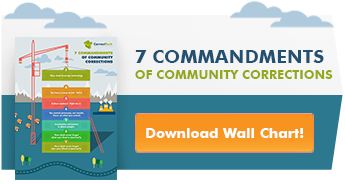 We corrections professionals love to drop the r-bomb. I’m not talking about responsivity, although it is a critical component of EBP that is often neglected if not outright ignored. I’m talking about RISK, that four-letter word that precedes need every time we talk about supervising justice-involved individuals. Assessing criminogenic risk is fundamental to our mission; that’s a given. But what message do we send when we say someone is high risk? Are we poisoning the well, compounding the stigma, and adding barriers to achieving those other coveted “r-words” - rehabilitation, reintegration, and recidivism reduction?
We corrections professionals love to drop the r-bomb. I’m not talking about responsivity, although it is a critical component of EBP that is often neglected if not outright ignored. I’m talking about RISK, that four-letter word that precedes need every time we talk about supervising justice-involved individuals. Assessing criminogenic risk is fundamental to our mission; that’s a given. But what message do we send when we say someone is high risk? Are we poisoning the well, compounding the stigma, and adding barriers to achieving those other coveted “r-words” - rehabilitation, reintegration, and recidivism reduction?
When we identify someone as "high risk," we know this means the individual is more likely to recidivate based on personal history factors and actuarial calculations built into the various assessment instruments. Risk/needs assessment provides a starting place for supervision and information about needs to share with treatment providers. We know that some risk factors never change (e.g., Bubba went to prison when he was 18 years of age and has six prior felony convictions), while other factors like time employed, residence stability, and program participation change from day to day. We understand what goes into risk assessment and how it can change.
Now, let’s look at this term “high risk” from the layman’s perspective. The first thought in that context might be, “Why are you letting this guy you call “high risk” out on the street? That’s not safe!” WE might have the same reaction without knowing the context. Are we fueling misguided talk and unintentionally rousing up justice reform resistance groups? I can hear it now: “No one in their right mind would want a high-risk criminal living in the house next door, would they? There’s no telling what could happen!”
And that’s exactly right. There is no telling what could happen. With the right interventions that focus on addressing criminogenic needs during community supervision, the so-called “high-risk criminal” might just learn and develop vocational, educational, and cognitive behavioral skills to embrace desistance and become a productive citizen instead of wasting time sitting on a prison bunk, learning how to become a better criminal.
 The point I’m trying to make here is that labels can produce unintended negative results. Categorizing people leads to depersonalization, and depersonalization leads to objectification. Ultimately, objects are more expendable than people. When we objectify justice involved individuals by calling them names like convict, offender, thug, or even “high-risk case,” we are able to marginalize them, to forget about their positive qualities, to desensitize ourselves to the trauma inflicted on their families, and become comfortable with locking them away. But that's okay, because, after all, they aren't like us and they get what they deserve.
The point I’m trying to make here is that labels can produce unintended negative results. Categorizing people leads to depersonalization, and depersonalization leads to objectification. Ultimately, objects are more expendable than people. When we objectify justice involved individuals by calling them names like convict, offender, thug, or even “high-risk case,” we are able to marginalize them, to forget about their positive qualities, to desensitize ourselves to the trauma inflicted on their families, and become comfortable with locking them away. But that's okay, because, after all, they aren't like us and they get what they deserve.
Wrong. That's not okay.
Before anyone starts shaking his or her head, muttering that this article was written by a bleeding heart, touchy-feely, “hug-a-thug” kind of guy, I must say that I wholeheartedly believe and agree that some individuals should be imprisoned. Some individuals may even be absolutely incorrigible. Some.
A vast amount of justice involved persons, though, are damaged people who, for whatever reason – whether it was Adverse Childhood Experiences (ACEs), drug addiction, poor coping skills, or just not ever being taught how to act appropriately – engage in unacceptable behavior. They could – and would – change with the proper intervention, especially when the interventions are geared toward their individual responsivity. But I’m “preaching to the choir,” as the saying goes.
Determining responsivity and treatment dosage require communication as well as historical knowledge of the individual. As community supervision practitioners we must consistently and continually engage folks to figure out not just what works, but what works for them. To do this, we have to gain their trust and confidence that we see them as a person, and not just a case number.
Criminal Justice Reformers have made a pointed effort to change how the public talks about the folks we supervise. Terms like “Justice-involved Individual,” “Returning Citizen,” and even “folks we supervise” have been coined in recent times to soften the hardline stance that is commonplace in public discussions and political rhetoric, in an attempt to facilitate a change of attitude and a change of heart. Now, we practitioners ought to go a step further and coin a new term, so no one gets shortchanged.
If we don’t call it “risk,” what do we call it? One suggestion is “concern factor.” Replacing “high or moderate risk” with “elevated or moderate concern” mitigates the fear factor associated with the “r-bomb.” This small drip on the front-end has the potential to ripple throughout the reintegration process by shifting our perspective as practitioners, and imbuing a softened attitude throughout the public at large. The sooner we stop dropping the r-bomb in polite conversation the better.
What do you think?


